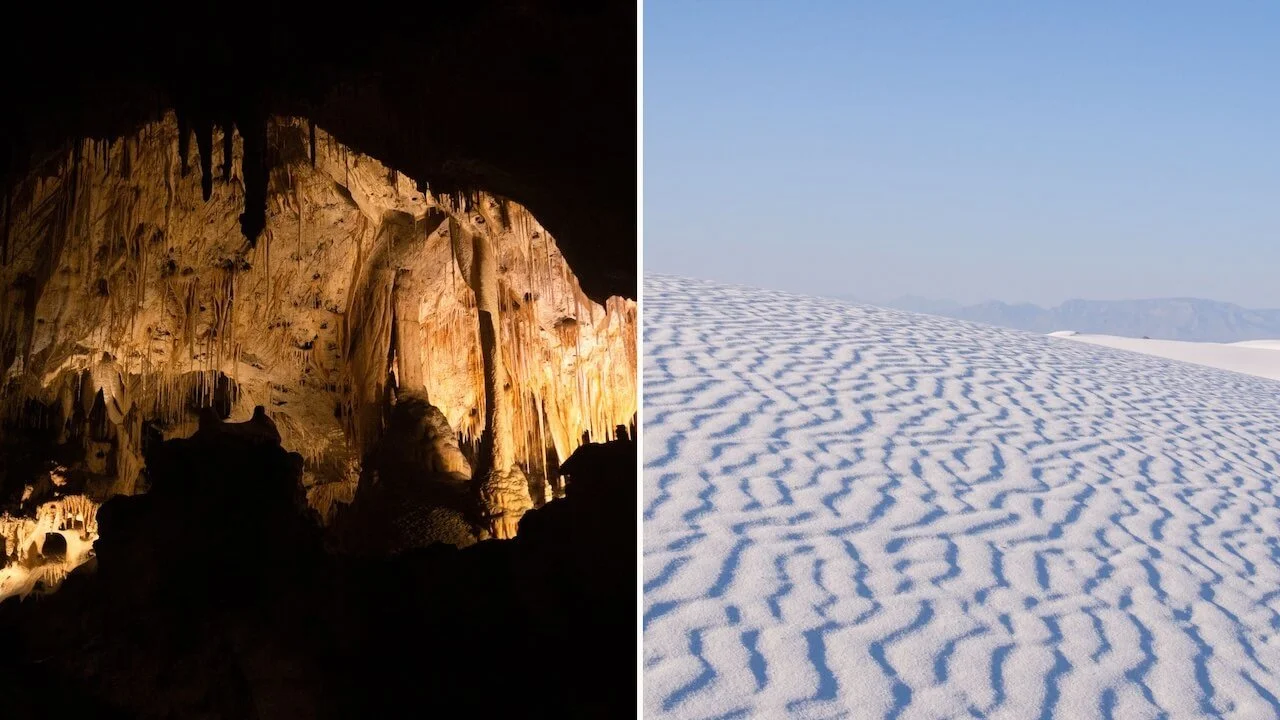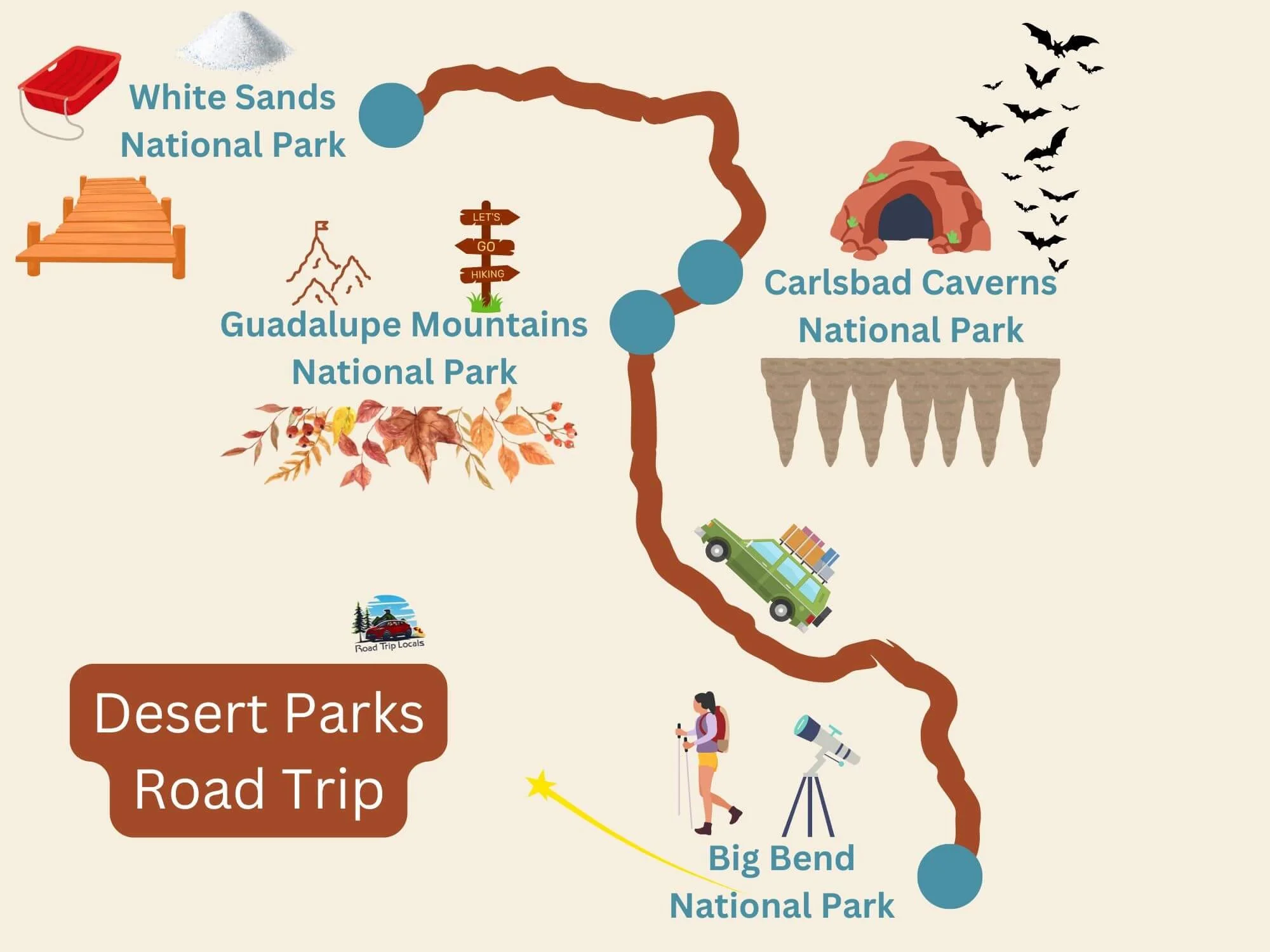Desert Parks: Texas and New Mexico Nat’l Park Road Trip Itinerary
We’re calling this road trip itinerary Desert Parks, a desert-meets-mountains road trip through West Texas and southern New Mexico that connects four underrated but unforgettable national parks: Guadalupe Mountains National Park (TX), White Sands National Park (NM), Carlsbad Caverns National Park (NM), and (bonus) Big Bend National Park (TX).
You’ll go from high desert peaks to glowing white gypsum dunes to vast underground cave systems, all within a few hours' drive of one another. It’s a hidden gem of a route, perfect for winter or shoulder season exploration. Let’s go!
What are the national parks in Texas?
Texas is home to two national parks: Big Bend National Park and Guadalupe Mountains National Park. Big Bend is located in the remote southwestern corner of the state and offers river canyons, desert hikes, and some of the darkest skies in the country. (It’s a hike to get there, even from our home base in Dallas, but it’s well worth the trek.) Guadalupe Mountains, located in West Texas near the New Mexico border, is known for its rugged mountain peaks, scenic canyons, and the highest point in Texas.
What are the national parks in New Mexico?
New Mexico has two national parks as well: Carlsbad Caverns National Park and White Sands National Park. Carlsbad Caverns features vast underground chambers filled with stalactites, stalagmites, and bat colonies, while White Sands is famous for its massive fields of bright white gypsum dunes perfect for photography, hiking, and sand sledding.
Texas and New Mexico National Parks Map
This road trip connects Guadalupe Mountains National Park, Carlsbad Caverns National Park, White Sands National Park, and optionally Big Bend National Park, giving you a perfect mix of rugged mountains, massive sand dunes, mysterious caverns, and remote desert beauty.
After driving this loop ourselves, we’ve put together an overview map showing how these parks connect, plus nearby activities and key stops you won’t want to miss. Use it to chart your own adventure, whether you’re spending a long weekend or a full two weeks exploring this incredible region!
What’s the best time of year to road trip Texas and New Mexico?
The best time of year for a Texas-New Mexico National Parks Road Trip is October through April. These months bring mild daytime temperatures, cool nights, and lower crowds than peak summer. February in particular is a sweet spot: it’s one of the best times to visit Big Bend for stargazing, with crisp, clear skies and minimal light pollution. Winter constellations are often visible in their full glory, and the cooler temps make hiking the desert trails more enjoyable. This time of year is also ideal for exploring caves at Carlsbad and catching soft light across the dunes at White Sands.
There’s one caveat to this! If you’re hoping to see lots of bats at Carlsbad Caverns and experience the Bat Flight Program, you’ll want to visit in August through September. This is the best time of year to see lots of bats emerge from the caverns in search of food each evening.
How long do I need for this road trip?
If you’re not planning to visit Big Bend, aim for 4–6 days to fully enjoy this loop without feeling rushed.
Spend 1–2 days in Guadalupe Mountains hiking, camping, and stargazing under some of the darkest skies in Texas. Then head to Carlsbad Caverns for one full day, making time for both the Big Room and either the elevator or Natural Entrance Trail (or both).
White Sands is perfect for a day trip, especially if you go for a sunset stroll, try some dune sledding, or take photos during golden hour. And don’t forget to leave an extra day for travel time, rest, or optional side adventures like McKittrick Canyon or ranger-led programs.
If you're adding Big Bend National Park, plan for 2–3 extra days. It’s worth it for the remote desert hikes, epic canyons, riverside hot springs, and world-class stargazing. This addition turns your trip into a full southwest desert circuit!
Best Things to Do and See on a Desert Parks Road Trip
This route covers vastly different ecosystems and landscapes, and each park offers something unforgettable. Here's a more detailed look at what to do in each one.
Guadalupe Mountains National Park
Guadalupe Peak Trail: At 8.4 miles round-trip and 3,000 feet of elevation gain, this is a strenuous hike, but it rewards you with panoramic views from the highest point in Texas (8,751 feet).
Devil’s Hall Trail: A 3.8-mile round-trip moderate hike through a narrow canyon with natural rock steps and stunning cliffs.
McKittrick Canyon Trail: Great for fall foliage, this trail follows a dry creek bed and leads to the historic Pratt Cabin. You can extend it to The Grotto or the Hunter Line Cabin.
Carlsbad Caverns National Park
Natural Entrance Trail: A 1.25-mile descent into the cave, equivalent to walking down a 75-story building. It’s steep but spectacular.
Big Room Trail: A flat, 1.25-mile loop inside the largest single cave chamber in North America.
King’s Palace or Lower Cave Tours: Reserve early for ranger-guided tours into deeper, less-traveled areas of the cave.
Bat Flight Program: From May to October, watch thousands of bats fly out of the cave at dusk!
White Sands National Park
Alkali Flat Trail: A 5-mile round-trip loop through the heart of the dunes for those wanting a backcountry feel (no shade, so go early!).
Interdune Boardwalk: A short, accessible trail with informative signs that’s great for all ages and abilities.
Backcountry Camping: For those comfortable with primitive conditions, pitch your tent between the dunes and enjoy sunrise/sunset in total silence.
Photography Tip: Arrive early or stay late. Soft light during sunrise and sunset makes the dunes glow! Bring a sled (or rent one nearby) for a fun, kid-friendly adventure.
Big Bend National Park
Santa Elena Canyon: One of the most iconic hikes in the park that’s short, easy, and incredibly scenic along the Rio Grande.
The Window Trail: A moderate 5.5-mile round-trip hike in the Chisos Basin that ends at a dramatic pour-off with a framed view of the desert below.
Boquillas Hot Springs: A relaxing riverside soak near the historic district. Great in the morning or evening.
Lost Mine Trail: A favorite moderate trail with sweeping views of the mountains and desert. Go early to beat the heat.
Stargazing: Big Bend is one of the darkest night sky locations in North America. It’s perfect for astrophotography or just looking up!
Know Before You Go: Practical Tips
Bring layers: It can be 70°F and sunny in White Sands, and freezing at Guadalupe Peak the next morning.
Carry at least 3 liters of water per person per day, especially when hiking during warm months.
Buy or bring headlamps and backup flashlights if doing ranger tours or exploring darker areas.
Gas up in towns before entering the parks as some have no fuel stations for miles.
Download offline maps or GPS apps in advance (AllTrails, Gaia, Google Maps offline).
Book cave tours and camping early!
Closest airports: El Paso (ELP) or Albuquerque (ABQ) ✈️
Drive Times Between Parks
Here are some approximate drive times between the parks in New Mexico and Texas to help you plan your route.
Guadalupe Mountains → Carlsbad Caverns: ~30 minutes to 1 hour
Carlsbad Caverns → White Sands: ~3.5 hours
White Sands → Guadalupe Mountains: ~3 to 3.5 hours (if going direct)
Guadalupe Mountains → Big Bend: ~3.5 to 4 hours
Big Bend → Carlsbad Caverns: ~5 hours
Big Bend → White Sands: ~6 hours (not a typical route but possible if looping)
These drive times make this a very doable 3- or 4-park road trip. Just be sure to gas up before long stretches and download offline maps in case of limited service.
Affiliate Disclosure: Some of the links in this section are affiliate links, which means we may earn a small commission if you make a purchase through them—at no extra cost to you. We only share places and products we truly love.
FAQ: Desert Parks Road Trip
How long does it take to drive between the parks?
The three main parks—Guadalupe Mountains, Carlsbad Caverns, and White Sands—are all relatively close to one another, making this a very efficient loop. It takes about 30 minutes drive between Guadalupe Mountains and Carlsbad Caverns, and roughly 3.5 hours to drive from Carlsbad Caverns to White Sands (depending on traffic and road conditions).
What order should I do the parks in?
Start in El Paso and go Guadalupe Mountains → Carlsbad Caverns → White Sands, or reverse it. If you’re adding Big Bend, start there, then loop north.
Do I need timed-entry reservations or park passes?
You don’t need timed-entry reservations for these parks, but you do need a park pass or entrance fee for each. The America the Beautiful Pass covers all of them and is a great value if you’re doing a multi-park trip.
Where should I stay overnight?
Try Carlsbad for access to Carlsbad Caverns and Guadalupe, and Alamogordo or Las Cruces for White Sands. If adding Big Bend, consider Terlingua, Lajitas, or the Chisos Basin Lodge inside the park.
For this route, we like Courtyard by Marriott Las Cruces, TownePlace Suites by Marriott Carlsbad, and Chisos Mountain Lodge.
Is cell service reliable?
Nope. Expect spotty to no service in Guadalupe, Carlsbad Caverns, and Big Bend. Download maps ahead of time and let someone know your route.
How hot does it get in the summer?
Very hot. Expect highs over 100°F in all parks. Heat exhaustion is a real risk, so avoid hiking midday, hydrate constantly, and plan early morning or late-day activities.
Can I visit these parks with kids?
Yes! Carlsbad’s elevator makes the caves accessible, sledding at White Sands is a hit with all ages, and there are short hikes at each park. Just prepare for the sun, heat, and elevation changes.
Are pets allowed in these parks?
Pets are welcome in some areas but very limited overall in Texas and New Mexico national parks, especially on trails. Based on our experience:
White Sands National Park is surprisingly pet-friendly; leashed dogs are allowed on most dunes and trails, making it a great stop for travelers with pets. (Our dog, Lincoln, traveled with us and loved it!)
Carlsbad Caverns National Park is not pet-friendly for underground tours or most park areas. Pets are only allowed in the parking lots and campground, and it can get very hot for them in the car. (Carslbad Caverns makes a great day trip, so it’s best to leave pets behind in a safe lodging situation.)
Guadalupe Mountains National Park is very limited for pets. Dogs are only allowed in campgrounds and on paved roads or parking areas (essentially just in your car or at your campsite). They’re not permitted on any trails.
Big Bend National Park is mixed. Dogs are allowed in developed areas and a few dirt roads, but not on hiking trails. There are some pet-friendly cabins near the park in Chisos Mountain Lodge, but they’re limited and often book 12–18 months in advance, so plan ahead.
Always check each park’s official rules before your trip, keep pets leashed, and remember that desert temperatures can be dangerous for dogs left in vehicles.
Can I do this road trip in winter?
Yes, and it’s a great time to go! Expect cooler temps, fewer crowds, and crisp skies. Just know that snow or ice is possible at higher elevations in Guadalupe Mountains, and some ranger programs may be limited seasonally.
Do I need to book cave tours in advance?
Yes! Ranger-led tours at Carlsbad Caverns book up fast, especially in spring and summer. Reserve on recreation.gov as soon as you know your dates.
What’s the best airport to fly into?
El Paso (ELP) is the most central. You could also fly into Albuquerque (ABQ) or Midland-Odessa (MAF) depending on your route.
Can I extend this into a longer Southwest trip?
Absolutely! Consider adding Big Bend, or going further north to Santa Fe, Roswell, or even Saguaro National Park in Arizona. Check out our 10-day New Mexico Road Trip itinerary here. You might even consider timing your road trip with the Albuquerque Balloon Festival!
Plan Your Trip
Travel Season, but make it local. That’s our motto for our 2025 Travel Season: Texas and the Southcentral. Follow along as we explore our own backyard here in Texas.
Not sure what to pack? Check out our Road Trip Packing List for the exact things we use and love on every trip!
Want to plan another adventure? Explore our Free Resource Library for road trip itineraries, planning guides, and stories from the road.
And if Yellowstone’s on your list, don’t miss our Yellowstone Travel Guide: your step-by-step companion to planning an unforgettable trip to Yellowstone National Park!
Related Posts















